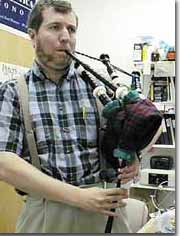Jorge Pullin
Jorge Pullin has made a career of studying a weighty subject: gravity. A professor at Louisiana State University, Pullin uses general relativity, Einstein's theory of gravity, to predict what will happen when black holes collide. Pullin became interested in gravity as a graduate student in Argentina. At a gravitational physics meeting there, he met Gabriela González, another Argentine physicist. A few years later, they were married. “I guess we are a living example that Einstein was wrong when he said that gravitation cannot be held responsible for people falling in love,” Pullin said.

Jorge Pullin playing the bagpipe.
Pullin grew up in Buenos Aires. His family came from England and Scotland in the early 1900s, and he was involved in the large Scottish community of Buenos Aires. As a teenager, he learned to play the bagpipes. He was also interested in figuring out how things worked. “I was, as a kid, always interested in technical stuff, playing with electricity, radios, cars,” he said. He went to college at the University of Buenos Aires. He intended to keep up his interest in technical matters by studying engineering, but after his first year, realized he was more interested in physics. “I enjoy the freedom to investigate what I want, and to basically understand things,” he said. After his second year of college, he moved to the Instituto Balsiero, a physics research institute in Bariloche, a city high in the Andes Mountains. He moved to Cordoba for a Ph.D., where he began to study gravity and met his wife. In 1989, he moved to the United States as a postdoctoral researcher. In 1993, Penn State started a center for the study of gravity, and hired Pullin as a faculty member. This July, he became chair of theoretical physics at LSU.
Pullin is involved with two research projects at LSU. First, he works with other scientists in an attempt to rewrite Einstein's laws of general relativity to include another influential theory of 20th century physics, quantum mechanics. Second, he uses Einstein's laws to make predictions useful to the Laser Interferometer Gravitational Wave Observatory (LIGO) project, an experiment designed to detect “gravitational waves,” ripples in the fabric of space that general relativity says should form when black holes collide. LIGO uses two giant machines called interferometers, one in Washington State and one in Louisiana, which should vibrate slightly as gravitational waves pass. “The detection of these waves is an enormous experimental challenge,” Pullin said - general relativity predicts that the interferometer's mirrors will move less than the radius of a proton. “[LIGO scientists] would be quite happy if we theorists could come and tell them what sort of wave patterns they're supposed to see. That would make their lives easier when they tried to detect them.” Pullin hopes to tell LIGO what to look for. He designs computer simulations that tell him what gravity waves will be produced when black holes of different masses and separations collide from different angles.
To conduct his research, Pullin has moved from one continent to another, and he studies events taking place in other galaxies. But he maintains ties to his home in Buenos Aires: he still plays the bagpipes regularly. “It's the only musical instrument I know how to play, and I like music very much,” he said.
An interferometer consists of two long arms. Scientists shine light from the arms' junction to mirrors at their ends, which reflect light back to the junction. When they reach the junction, the light beams interact with one another, forming a distinctive “interference pattern.”
The arms in each LIGO interferometer are 4 kilometers (2.5 miles) long. When a gravitational wave passes through one arm of the interferometer, it makes the space that the arm occupies vibrate slightly. The vibration distorts the interference pattern at the junction. If scientists see the same interference pattern at both LIGO machines, they will have strong evidence that a gravitational wave passed through.











